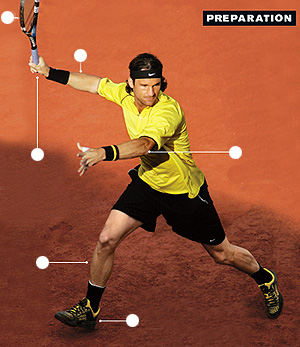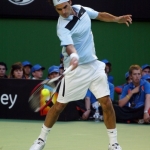(모야) Open-Stance Forehand
| 첨부 '1' |
|
|---|

Carlos Moya uses a huge backswing and excellent body rotation to power his open-stance forehand.
PREPARATION
RACQUET:
Moya brings his racquet back above head level. Starting his swing from this point will enable him to generate plenty of racquethead speed. In order to take such a large swing you need time to measure the ball.
(라켓헤드는 머리보다 약간 더 위에 위치.. 이 위치에서 스윙을 시작하면 스윙스피드를 빠르게 할 수 있다.)
GRIP:
Like many claycourt players, Moya uses an extreme Western grip on his forehand. This closes the racquet face, which allows a player to drop the frame below the ball and brush up for heavy topspin.
RIGHT ARM:
Moya’s hitting arm is almost completely straight and extended away from his body. This is good for power but problematic unless you have superb timing. The average player would be wise to bend the arm a little, keeping the elbow closer to the body.
(모야는 팔꿈치가 몸에서 약간 떨어져 있는데, 보통의 동호인은 몸에 가깝게 하는 것이 더 낫다)
LEFT ARM:
What you do with your nonhitting arm is important on a forehand. Here you see Moya bringing it over to the hitting side, which naturally rotates his upper body (his chin is over his left shoulder) and counterbalances his racquet arm.
(상체를 회전시켜 줄 것이고, 오른손에 대한 counterbalance 역할을 할 것이다.)
RIGHT LEG:
By loading up and hitting off his back leg, Moya is using open-stance footwork. He has started to flex his right knee and will probably bend it a little more to further load his weight onto that leg and explode up and through the shot.
(어느 정도는 구부려야 파워를 낼 수 있다)
RIGHT FOOT:
The toes on Moya’s right foot are pointing to the side, which facilitates his hip turn. If the plant foot is more perpendicular to the net, it’s much more difficult to get that rotation.
(오른발이 가르치는 방향은 약간 비스듬해야 한다. 그래야 히프를 돌릴 때 회전이 잘 된다. 만약 네트와 수직으로 있다면, 히프를 회전하기가 쉽지 않다.)
[테니스는 어떻게 완성 되는가?]
| 번호 | 제목 |
|---|---|
| 공지 |
테니스 관련 정보,랭킹,엔트리, 생방송 사이트 링크 모음
|
| 9847 | (**)(벽보드연습드릴) 포2개 <---> 백슬라이스 2개 |
| 9846 | (최경주) 매일 10분이라도 꾸준히.. 다른 왕도는 없다 |
| 9845 | 다양한 shadow 포핸드 연습드릴 |
| 9844 | [re] 발리의 기본은 '블락발리'.. 빠른 공의 리턴이 기본 1 |
| 9843 | 안녕하세요? 1 |
| 9842 | 발리의 기본은 '블락발리'.. 빠른 공의 리턴이 기본 1 |
| 9841 | 팀 헨만이 알려주는 tennis tip |
| 9840 | The Direction Reaction |
| 9839 | [동영상]드라이브 트레이닝 4 |
| 9838 | 줄넘기에 대한 메뉴얼.. 다리를 가볍게 하는 데는 |
| 9837 | "다음 공이 바로 전 공보다 훨씬 중요하다" |
| 9836 | (*)서브의 placement 연습법.. 3개 연속 성공하면 다른 곳 시도 |
| 9835 | The Ten Commandments of Singles |
| » |
(모야) Open-Stance Forehand
|
| 9833 |
페더러를 통해 본 공-그립-눈의 위치
4 |
| 9832 |
공-그립-눈의 위치
1 |
| 9831 | 질문 - 라켓 무게 중심에 따른 차이가 있는지요?? 1 |
| 9830 | 테니스 비디오녹화테잎 구입하고 싶은데.. |
| 9829 | 질문이 있습니다. 1 |
| 9828 | [환영합니다! 1 |

